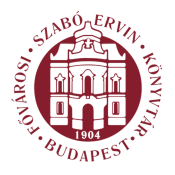Matits Ferenc: Protestant Churches - Our Budapest (Budapest, 2003)
The central heating system of the church and the school was designed by engineer Károly Knuth. The external sculptural decoration is the work of Ignác Langer, while the baptismal font was carved in the workshop of j. Kauser 8 Co. The organ was built by the Angster company, the bells were cast in the factory of Frigyes Seltenhoffer and the clock in the tower was delivered by József Sowinszky. Frigyes Glück made several donations to facilitate the completion of the church building. The marble banister surrounding the altar is his gift as are the stair-banister of the pulpit, also carved of marble, and the former stained-glass windows of the sanctuary with the standing figure of Christ and the representation of the four evangelists. The faces in the stained-glass windows were portraits of Glück's three grand-children. The Lutheran Church of Kőbánya No. 14 Kápolna utca, District X In 1873, the year of Budapest's unification, Kőbánya united with the capital. The ensuing period saw a massive population growth, affecting the Lutheran community, too, due to the factories that were built here. From 1879 for twenty years, Lutheran church services were held in the various schools of the district; in 1900 the newly built Calvinist church accommodated the Lutheran community until its own church was completed. In 1908 the congregation received a plot from the Budapest municipality and launched a fund-raising campaign to cover the expenses. The funds thus accumulated were rendered useless by the privations of World War 1 and the inflation that followed. In the second half of the 1920s, the community managed to swap the gift-plot for another, better, one. In 1928, the parish invited eight architects to submit tenders for a church to be built on this triangular site bordered by Kápolna utca and Kápolna köz. Alongside the church, two, symmetrically arranged, three-storey houses were to have been built with small studio-flats to designs made by the winner of the competition, architect János Frecska. However, the original plans had to be modified due to shortage of funds and there was only one, two-storey, wing raised behind the church. The parsonage, which fronts on Kápolna utca, and the church are connected by a staircase. Designs made by János Frecska were realised with effective support given by the Ministry of Public Welfare, the Finance Ministry and the municipality of Budapest on the one hand, and the generous donations of the local congregation on the other. Its external appearance, mass, dynamic proportions 20
